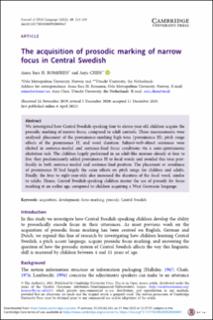| dc.contributor.author | Romøren, Anna Sara Hexeberg | |
| dc.contributor.author | Chen, Aoju | |
| dc.date.accessioned | 2023-02-27T10:04:15Z | |
| dc.date.available | 2023-02-27T10:04:15Z | |
| dc.date.created | 2021-01-29T11:21:12Z | |
| dc.date.issued | 2021 | |
| dc.identifier.citation | Journal of Child Language. 2021, 49 (2), 213-238. | en_US |
| dc.identifier.issn | 0305-0009 | |
| dc.identifier.issn | 1469-7602 | |
| dc.identifier.uri | https://hdl.handle.net/11250/3054128 | |
| dc.description.abstract | We investigated how Central Swedish-speaking four-to-eleven year-old children acquire the prosodic marking of narrow focus, compared to adult controls. Three measurements were analysed: placement of the prominence-marking high tone (prominence H), pitch range effects of the prominence H, and word duration. Subject-verb-object sentences were elicited in sentence-medial and sentence-final focus conditions via a semi-spontaneous elicitation task. The children largely performed in an adult-like manner already at four to five: They predominantly add prominence H to focal words and avoid this tone post-focally in both sentence-medial and sentence-final position. The placement or avoidance of prominence H has largely the same effects on pitch range for children and adults. Finally, four to five-year-olds and seven to eight-year-olds also increase the duration of the focal word, similar to adults. Hence, Central Swedish-speaking children master the use of prosody for focus marking at an earlier age, compared to children acquiring a West Germanic language. | en_US |
| dc.language.iso | eng | en_US |
| dc.publisher | Cambridge University Press | en_US |
| dc.relation.ispartofseries | Journal of Child Language;Volume 49 , Issue 2 | |
| dc.rights | Attribution-NonCommercial-NoDerivatives 4.0 Internasjonal | * |
| dc.rights.uri | http://creativecommons.org/licenses/by-nc-nd/4.0/deed.no | * |
| dc.title | The acquisition of prosodic marking of narrow focus in Central Swedish | en_US |
| dc.type | Peer reviewed | en_US |
| dc.type | Journal article | en_US |
| dc.description.version | publishedVersion | en_US |
| dc.rights.holder | © The Author(s), 2021 | en_US |
| cristin.ispublished | true | |
| cristin.fulltext | original | |
| cristin.qualitycode | 2 | |
| dc.identifier.doi | https://doi.org/10.1017/S0305000920000847 | |
| dc.identifier.cristin | 1882176 | |
| dc.source.journal | Journal of Child Language | en_US |
| dc.source.volume | 49 | en_US |
| dc.source.issue | 2 | en_US |
| dc.source.pagenumber | 213-238 | en_US |

